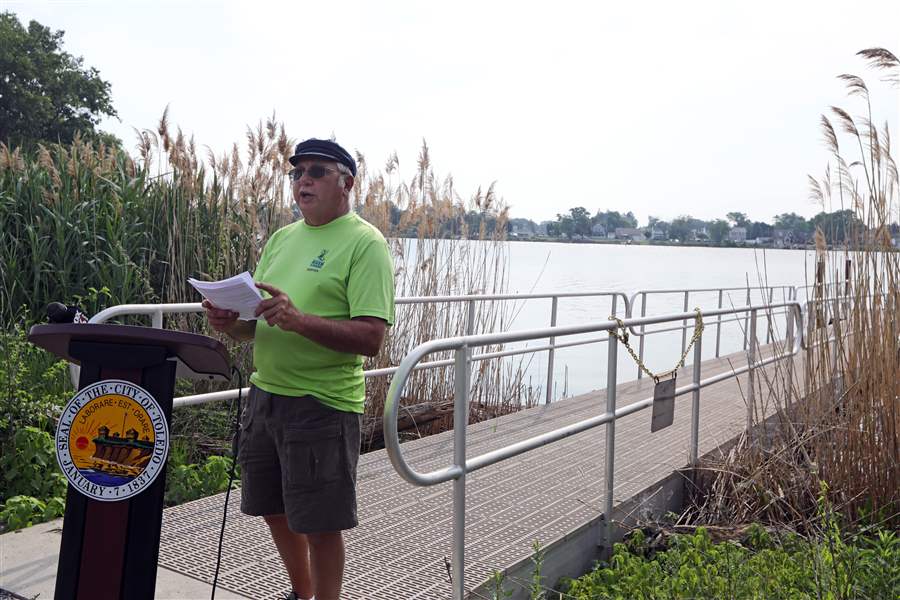
Toledo's Ottawa River takes another big step in its long healing process
6/18/2018
Bob Pulhuj, of Northwest Ohio River Runners, recalls how much has improved in the area in the past 50 years. He is one of the citizens whose refusal to accept the unhealthy conditions of the river helped to make a difference, says Mayor Kapszukiewicz.
THE BLADE/JETTA FRASER
Buy This Image
While agreeing more work needs to be done, Toledo Mayor Wade Kapszukiewicz said the end of a no-contact advisory for the lower 8.8 miles of the Ottawa River is another big step forward in improving a western Lake Erie tributary once known as Ohio’s most polluted waterway.
The significant achievement inspires cleanup efforts elsewhere and is a painful reminder that City Hall wasn’t nearly as attentive to Point Place as it should have been for many years, Mr. Kapszukiewicz said Monday morning while addressing reporters along the river’s shoreline.
“From the standpoint of perception, this is an important day,” Mayor Kapszukiewicz said. “There was a sense [in years past] that City Hall didn’t care about Point Place.”
RELATED: Lawsuit against Monsanto could benefit Ottawa River | Ottawa River shows health improvement
Now, as the Ottawa River’s water quality continues to improve and its legacy of pollution continues to fade, more people should be able to boat, water-ski, and fish, on the waterway, once again accessing recreational opportunities they were entitled to all along, Mr Kapszukiewicz said.
WATCH: State of Ohio has lifted a no-contact advisory at Ottawa River
That, in turn, should improve Point Place property values and help that part of the city prosper, he said.
The state of Ohio’s decision to remove the no-contact advisory follows a big improvement documented in 2017.
After 22 years of telling the public not to consume any Ottawa River fish caught between Main Street in Sylvania and the river’s mouth that empties into Lake Erie, Ohio Environmental Protection Agency Director Craig Butler announced last year that state agencies had determined it was safe to begin eating one meal a month of channel catfish, carp, and golden shiner, and one meal a week of pumpkinseed sunfish.
In 2011, the Ohio Department of Health lifted a no-contact advisory that had been in effect for the western half of a 17-mile stretch of the Ottawa River since 1991. That included degraded water and sediment that had long existed near the University of Toledo’s main campus, and other upstream locations.
Despite the continued signs of improvement, though, an Ohio EPA toxicologist said in 2016 the river probably will not be fully healed until 2030 — a point that officials reiterated Monday to help underscore the need for preventing pollution in the first place.
The no-contact advisory along the lower 8.8 miles had been in place for more than 25 years. Pollution in a formerly unnamed tributary, re-channeled and named Fraleigh Creek, was for many years the state’s worst spot for cancer-causing polychlorinated biphenyls.
Point Place itself was never a significant contributor to the pollution. But because it lies downstream of one of the state’s hottest zones for industrial chemicals, a one-mile stretch of river between Stickney Avenue and Lagrange Street, it took a disproportionate brunt of the consequences.
Residents there for years complained how PCBs that had leaked out of a number of landfills between Stickney and Lagrange made water unsafe for activities such as water-skiing. More than $100 million has been spent capping the worst of those landfills.
Mr. Kapszukiewicz said the river’s reputation got so bad the mere mention of its name used to carry a negative connotation.
But after much of the landfill work was done in the late 1990s and early 2000s, the city worked with the U.S. EPA and a number of contractors on a $47 million environmental dredge along a 5.5-mile industrialized stretch of the river west of Suder Avenue in 2009-10.
It was the Great Lakes region’s largest project of its kind during that funding cycle, one that also involved contributions from many businesses and corporations identified in federal court as potentially responsible parties.
More recently, Toledo has spent more than $97 million on holding tanks and other devices to reduce overflows of raw sewage after heavy rain.
That work is part of the city’s $527 million Toledo Waterways Initiative that voters authorized in 2002 to help Toledo end years of litigation with the U.S. EPA over sewage spills that have fouled western Lake Erie tributaries for decades.
All TWI work is to be completed in 2020, according to a federal court agreement.
Bob Pulhuj is skipper of Northwest Ohio River Runners, a group that for the past eight years has led as many as 20 kayakers a week on trips along the Ottawa River from late spring to early fall.
He said the river’s sights and even its smells are vastly improved, with wildlife regaining its foothold along the shoreline.
“The Ottawa River has regained her beauty and strength,” Mr. Pulhuj said. “She is alive again.”
He said he sees the same potential for Swan Creek in South Toledo.
Patrick Lawrence, a University of Toledo geography professor who formerly served as president of the local Partners for Clean Streams and as a former chair of the Maumee Remedial Action Plan Advisory Committee, said the Ottawa River is healing because of collaborations among countless agencies, groups, volunteers, and experts.
“Rivers for me are about people,” Mr. Lawrence said. “If they experience and enjoy it, they’re going to value it.”
Contact Tom Henry at thenry@theblade.com, 419-724-6079, or via Twitter @ecowriterohio.